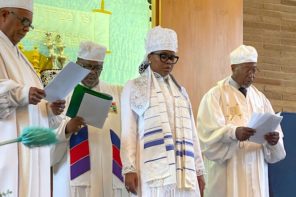It used to be commonly held that Orthodox Jews were more interested in ritual observances—the obligations between people and God—while Reform Jews were interested in charity and justice, or the obligations among people. (No one really knew where the Conservative movement stood…)
The last decade has changed all this. On the one hand there has been an unprecedented growth of Jewish social justice organizations; groups like California’s Progressive Jewish Alliance, Avodah: The Jewish Service Corps, the environmental group Hazon, American Jewish World Service, Jewish Funds for Justice, the New York group Jews for Racial and Economic Justice, Jews United for Justice in Washington DC—the list goes on.
In addition, the eminence grise of Jewish social justice organizations, Chicago’s JCUA, hired Jill Jacobs, a Conservative Rabbi, as Director of Outreach and Education in 2004, and started a summer seminar for rabbis (modeled on Interfaith Worker Justice’s “Seminary Summer”) which integrates Torah study and the practice of social justice.
But what really stands out is the new, though cautious, embrace of social justice goals by the institutions of the Conservative and (to a much smaller extent) the Orthodox movements. Spurred on by the exposure of the unjust treatment of workers and the abuse of animals at the Agriprocessors meatpacking plant in Postville, Iowa, the Conservative movement launched the so-called heksher tzedek. This is a kosher seal of approval which guaranteed that the product under supervision was manufactured ethically—that workers’ rights were being respected and that animals were not being abused.
An Orthodox group called Uri L’tzedek (“Awaken to Justice”) organized shortly afterward to the same end. Also during this time, the Committee on Jewish Law and Standards of the Conservative movement’s Rabbinical Assembly approved a decision (a “responsa”) authored by Rabbi Jill Jacobs (by then having moved to the Jewish Funds for Justice as their Rabbi in Residence) requiring synagogues to pay their employees living wages.
Finally, the latest rabbinical seminary on the block, the Modern Orthodox Yeshivat Chovevei Torah (YCC) has a social justice track which culminates in doing a social project. (Canfei Nesharim was started by students at YCC.)
This is truly a revolutionary change. What does it look like? What does it mean?
Social Activist Jews Studying Talmud?
On a Sunday morning in the Los Angeles Jewish Community Center, twenty people gather around a table to study Jewish texts. The texts are out of the classical canon: the Bible, of course, but also the third-century Mishnah and its sixth-century commentary, the Babylonian Talmud, and the medieval jurist Maimonides. As people introduce themselves, it becomes clear pretty soon that most of the people in this room have not had positive Jewish educational experiences. Though some of the members of the group are more learned, most people describe their very elementary Jewish backgrounds in caustic and negative terms. Yet, these people voluntarily showed up on a Sunday morning to study Jewish texts for two hours.
This study session was not sponsored by a Jewish outreach or missionary organization, but, rather by the Progressive Jewish Alliance. The goal of the text study was to incorporate traditional Jewish perspectives into the training that the participants were getting as part of the PJA’s restorative justice project JCJP (Jewish Community Justice Project). After four two-hour sessions, the members of this group were excitedly employing a new conceptual vocabulary with which to think about restorative justice. This was not your grandfather’s liberal organization.
Over the past decade, it has become de rigueur in progressive and lefty Jewish settings to be studying Talmud as part of a discussion of workers’ rights, or to include Maimonides’ medieval code in a discussion of the death penalty, or to quote from the writings of twentieth-century Orthodox Rabbinical jurists to make a point about trying minors as adults.
So what does this all mean? I would like to suggest that this marks the third stage in an evolution from a desacralized language of social justice to the current reclamation of the language of tradition.
In the early twentieth century the Jewish pioneers of the social justice movements (especially around worker justice issues) used Yiddish as an organizing language but spoke “American.” The conceptual vocabulary of the union movement and the socialist movement was embraced by the Jewish participants in those movements; and continued to be used when those Jews started their own organizations, such as the American Jewish Congress. During the seventies (which was, for all intents and purposes, when the sixties hit the Jewish community) and eighties, there was a larger embrace of Jewish religious language, spurred on by the writings of Abraham Joshua Heschel and Gershom Scholem. However, the form and content of political speech remained the same as in other liberal-left organizations (with some exceptions, as in Arthur Waskow’s and Michael Lerner’s experiments with a spiritual-political language).
Taking Back the Texts
The first ten years of the twenty-first century, the “zeroes,” have brought about the beginning of the integration of the languages of politics and tradition.
This move to traditional study in the political camp coincides with, and is connected to a resurgence of the DIY Judaism movement (in which small groups gather for worship in what are called independent minyanim). In both camps, there is a lack of deference to traditional authority structures, while at the same time there is a claim being made on traditional forms of worship and study. To a certain extent it is a movement to “take back the texts.” Taking back the texts is seen as both a way to claim authenticity for political positions, but also a way to participate in a multiethnic and interfaith discussion from a grounded Jewish space and in a textured Jewish vocabulary.
This new tenor, tone, sensibility, aesthetic, and hermeneutic of social justice as a textually-grounded Jewish practice opens up the door to a new mode of envisioning Judaism and Jewish identity which moves beyond denominational labels (Orthodox, Conservative, Reform, Reconstructionist, Renewal, Humanist…). The Judaism that is being constructed by these practices is a Judaism which looks through the classical texts of the tradition towards the outside world. This is a certain fulfillment and correction of the process of post-Enlightenment Judaism, when the large arena of justice issues was abandoned to the discourse of the secular political process.
The new discourse holds the promise that there is insight within the specific conceptions of the Jewish textual tradition which is relevant to the concerns of the world at large.
One interesting question is what claim do the participants in these movements think that the texts make on them? While the texts supply a robust vocabulary, very useful in certain areas of social justice, they also bring with them the baggage that accompanies any centuries-old tradition. When some of the activists who are initiated in text study through the “progressive” parts of the tradition, run across the darker sides of the tradition, what will they do?
On my optimistic days I see a generation of “new Talmudists” who swim in the sea of Talmud, and whose questions are those that fuel their activism, and who are equally fearless in critiquing the dark sides of the canon they love. On other days…




